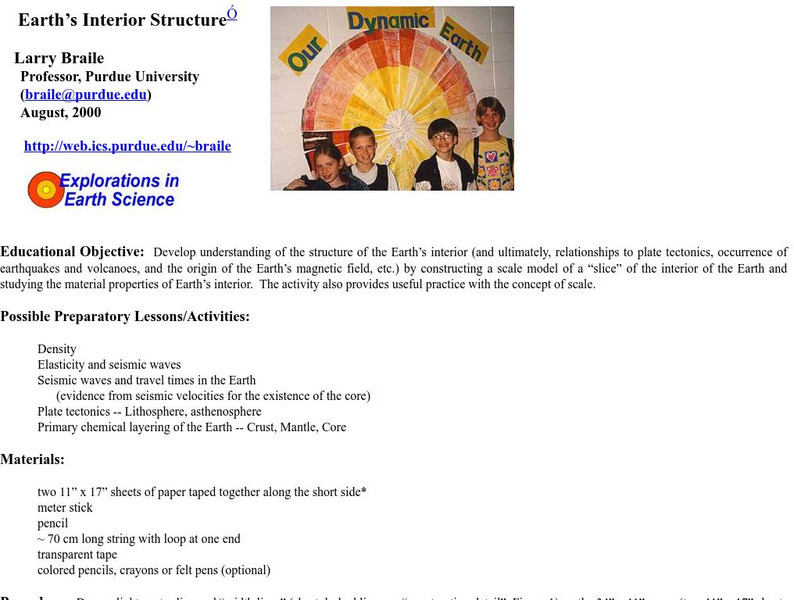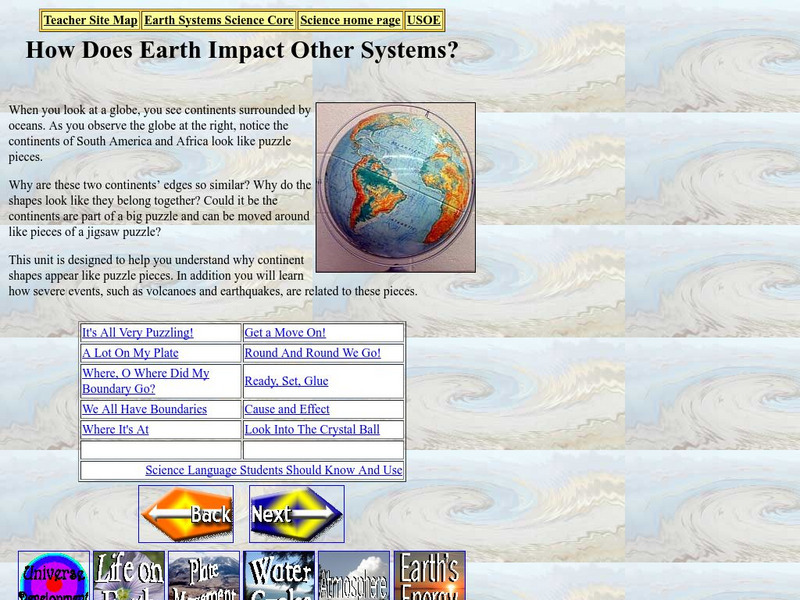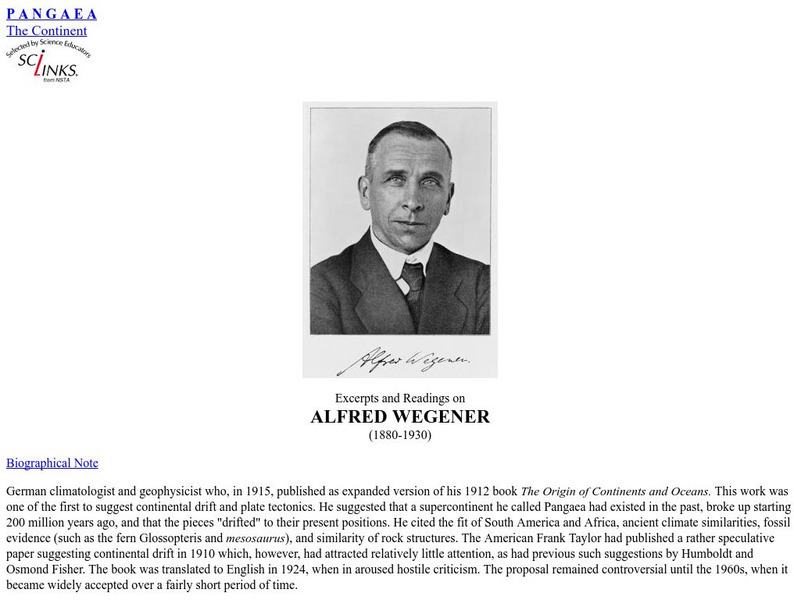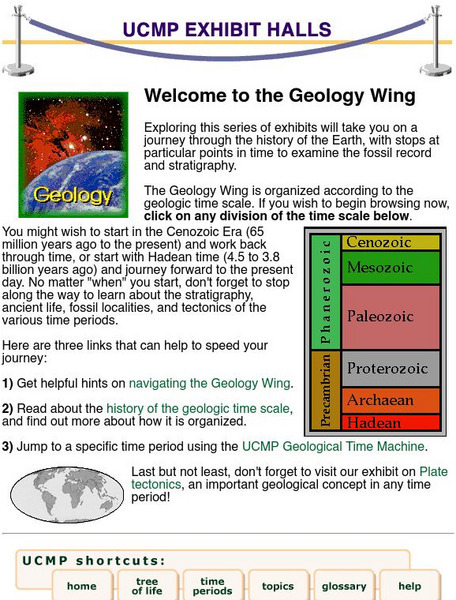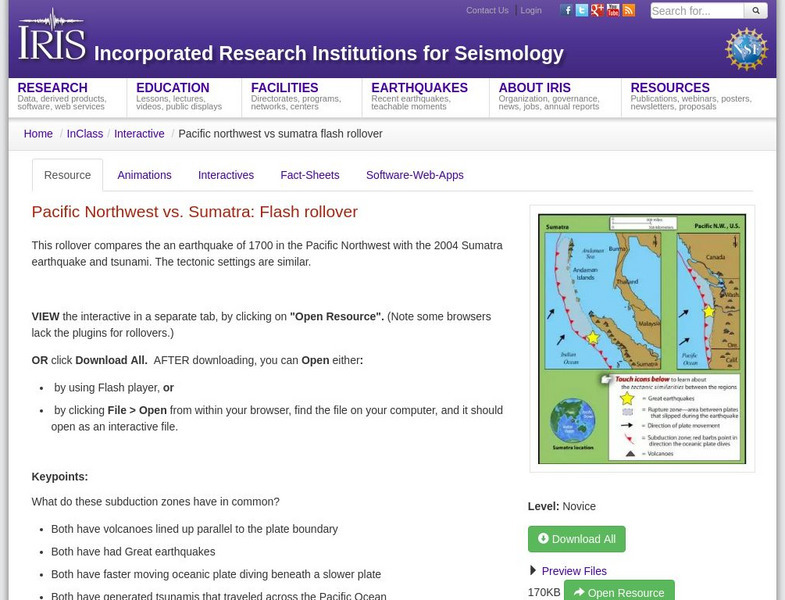Annenberg Foundation
Annenberg Learner: Volcanoes
This interactive from Annenberg Learner asks the question of whether erumptions of volcanoes can be predicted. Review what you already know about volcanoes, and move on to forecasting potential. Several short video clips are included as...
TeachEngineering
Teach Engineering: Volcanic Panic!
Students learn about the causes, composition and types of volcanoes. They begin with an overview of the Earth's interior and how volcanoes form. Once students know about how a volcano functions, they learn how engineers predict...
Purdue University
Purdue University: Earth's Interior Structure
Purdue University provides a great lesson plan for learning about the Earth's interior structure. Focuses on the crust, mantle and core. Also includes examples and great charts that students will enjoy looking at.
PBS
Wnet: Thirteen: Savage Earth: Waves of Destruction, a Tsunami Animation
View a brief animation that explains the science behind a tsunami.
Utah State Office of Education
Utah State Office of Education: How Does Earth Impact Other Systems?
Have you ever noticed how some of the continents and land masses of Earth seem to fit together like pieces of a puzzle? This unit is designed to help you understand why continent shapes appear that way. In addition you will learn how...
Science Struck
Science Struck: How Was the Mid Atlantic Ridge Formed?
Learn what the Mid-Atlantic Ridge is, how it was formed in the Triassic Period, the volcanic activity that takes place there, and the benefits and negative impact of this activity.
NASA
Nasa Space Place: What Is an Earthquake?
Discover why earthquakes happen, how we measure them, and why they only happen on Earth.
ClassFlow
Class Flow: Plate Tectonics Intro
[Free Registration/Login Required] This flipchart will take several class periods. This lesson begins to look at how the different landforms are created. There will be two follow up lessons - one on volcanoes and one on mountains.
ClassFlow
Class Flow: Plate Tectonics Volcano
[Free Registration/Login Required] This lesson will take several class periods. This lesson begins to look at how volcanoes are created.
Science Struck
Science Struck: Examples of Destructive Forces of Nature
Discusses the destructive forces unleashed by volcanic eruptions, and the movement of water, wind, ice, and tectonic plates.
Science Struck
Science Struck: Examples of Constructive Forces of Nature
Discusses the constructive forces resulting from volcanic eruptions and the movement of water, wind, ice, and tectonic plates.
Other
Paleomap Project
Virtual reality animation map showing continental drift from 200mya to the present. The animation map is small but effective in showing the positions of the land masses.
Other
Pangea: Alfred L. Wegener Biography
Two biographies of Wegener and his work including his theory on how raindrops form.
Math Science Nucleus
I. Science Ma Te: Integrating Science, Math and Technology
This site offers a wealth of online textbook-related materials that encourage the discovery of science in the world around us. Enter the site to access material on specific topics. Each section contains reading material (complete with...
Annenberg Foundation
Annenberg Learner: Dynamic Earth Interactive
Delve into the structure of the Earth to learn what causes earthquakes, volcanoes, and more.
Other
University of Wisconsin Green Bay: Faults and Earthquakes
This site is primarily set up as an outline and is loaded with graphs, maps, and images. It covers a variety of earthquake-related topics, such as what causes earthquakes, fault lines and structures, seismology, a historical look at...
Science Struck
Science Struck: Transform Boundary: Definition and Useful Examples
Explains what a transform boundary is and gives examples of well-known faults of this type.
US Geological Survey
Central California Earthquake Hazards Project
Here is a review of the geology behind earthquakes and what is being done to predict the "Big One" on the San Andreas Fault.
University of California
University of California Museum of Paleontology: Geology and Geologic Time
This site provides information about the geologic relationships of rock layers, as well as much about geologic time and the history of Earth.
National Institute of Educational Technologies and Teacher Training (Spain)
Ministerio De Educacion: Los Cambios en El Medio Natural I
In this unit you can learn about the internal structure of the Earth. It has 13 interactive activities.
Incorporated Research Institutions for Seismology
Iris: Pacific Northwest vs. Sumatra: Flash Rollover
This rollover compares the earthquake of 1700 in the Pacific Northwest with the 2004 Sumatra earthquake and tsunami.
Other
Scec: Wallace Creek Interpretive Trail
Go on a geologic adventure in this interactive, online trail guide to the Wallace Creek site on the San Andreas Fault.
Cosmo Learning
Cosmo Learning: Blue Planet: Introduction to Oceanography
A collection of video lectures from an introduction to oceanography course taught at the University of California, Los Angeles. The course gives a general introduction to the processes and history of Earth's global oceanic system in...
Cosmo Learning
Cosmo Learning: Engineering Geology
A collection of video lectures from a course introducing students to the basics of engineering geology. Webpage includes forty lectures from a professor at the National Programme on Technology Enhanced Learning. Lectures vary in length...
Other popular searches
- Map of Tectonic Plates
- Floating Tectonic Plates
- Geography Tectonic Plates
- Pacific Basin Tectonic Plates
- Movement of Tectonic Plates
- Tectonic Plates Converge
- Tectonic Plates Move Apart
- Tectonic Plates Oranges
- Edible Tectonic Plates
- Tectonic Plates and Volcanoes




